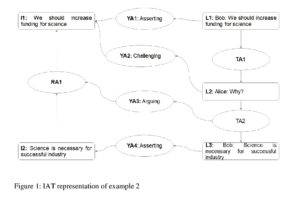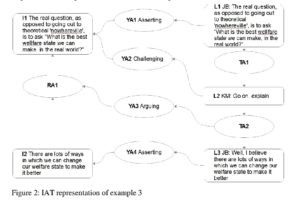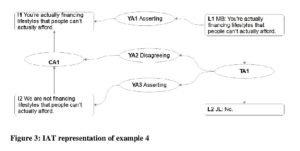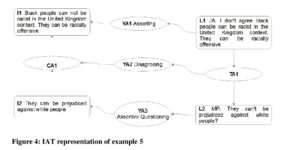ISSA Proceedings 2014 ~ Recognising Argumentation In Dialogical Context
No comments yetAbstract: The aim of the paper is to present an analytical method for the dialogical argument structure analysis. The method is used for the extension of the existing models of the recognition of argumentation which typically focus on inference indicators as cues for argument detection. In the proposed approach the aim is to identify argument structures via dialogue protocols. In the dialogue “Bob: We should increase funding for science; Alice: Why?; Bob: Science is necessary for successful industry” the standard method is not sufficient to recognise the argument. The solution is to use the Inference Anchoring Theory which allows us to understand how it is that when e.g. A asks why it is that p; and then B say q, we recognise an inference from p to q. In the paper sample analysis of the natural dialogues is presented using the transcripts of the BBC Radio4 program Moral Maze. Basing on those examples the method for recognition of argument pro- and con- in debate is presented.
Keywords: Argument mining, argument structure, corpus studies, dialogue protocols, inference anchoring theory, protocol for debate
1. Introduction
The aim of this paper is to introduce a procedure for the description of arguments performed in dialogues. Analysis of argument structure in this approach will be used as an ‘ore’ for the argument mining techniques, consisting of methods for automated and semi-automated argument extraction from texts in natural language. The proposed method is an extension of existing methods which typically focus on inference indicators such as “because”, “since”, “therefore” as cues for argument recognition (see e.g. van Eemeren et al. 2007). Let’s consider the following example:
Example 1
Bob: We should increase funding for science because science is necessary for successful industry.
In Bob’s utterance from example 1, argument structure can be easily recognised by means of the inference indicator “because” which allows recognition of the part “We should increase funding for science” as a premise, and “science is necessary for successful industry” as a conclusion of the argument. This method is usually used for the argument mining techniques (see Budzynska & Reed, 2011). Yet, it is not always sufficient for argument detection for all communicative situations, e.g. argumentation performed in the dialogue where there is no indicators. To illustrate such a situation, let’s consider Bob’s utterance from example 1 as it was performed during Bob’s conversation with Alice:
Example 2
Bob: We should increase funding for science
Alice: Why?
Bob: Science is necessary for successful industry
Here Bob’s argument cannot be recognised by means of procedure based of inference indicators description since this fragment does not contain any inferential components. The conclusion of the argument was performed by Bob in the first locution in example 2, and its premise was performed in the third locution. Moreover, between the premise and the conclusion performed by Bob, Alice executed one more locution which does not belong to the structure of the argument. Such a case becomes problematic when it comes to the description of automated method for dialogical argument recognition.
The motivation of this research is to explore the possibility of building an analytical method which will reliably work in situations like example 2, and be used for the techniques of automated and semi-automated argument extraction. Proposed method aims to identify argument structures not only via inferential components, but also via dialogue protocols, e.g. certain sequences of utterances in a dialogue (Budzynska et al. 2014). This procedure allows us to understand, e.g. how is that when one participant performs challenging move in a dialogue after which another participant via performing an assertive move performs also argumentation.
Proposed approach to argument structure recognition aims to deal with the resources in natural language, such as transcripts of conversations. In the current paper the analyses of structure of the argument is presented for the discourse of debate.
The paper consists of three parts. In section 2 the methodology for the analysis is described. In sections 3 and 4 the analyses of examples from corpus studies, in which structure for argumentation pro- and con- in debate is illustrated, will be presented.
2. Methodology
In this section the state of the art representing the background of the research is described. Firstly, theoretical framework introducing main assumptions and terms in the proposed model for argument identification if introduced (see: 2.1). Secondly, general description of the corpus studies during the analyses of debate is reported (see: 2.2).
2.1 Theoretical framework
The proposed method for the argument structure analysis is based on two theoretical models describing dialogue and argument structures. Firstly, during the dialogue structure analysis assumptions from formal dialogue systems (Hamblin, 1970) were taken. Then, during the dialogical argument structure description, inference anchoring theory (IAT) is used as a core framework for the analysis (Budzynska & Reed, 2011).
The concept of a dialectical system was introduced by Hamblin (1970), as a rule-governed structure of organised conversation. The main goal of such systems was to “model contexts for everyday conversation” which will allow us to analyse argumentation performed in natural communication (Walton & Krabbe, 1995). Formal dialogue systems aim to determine rules governing the course of a dialogue. Currently a lot of systems are built depending on the type of conversation those systems aim to model, e.g. system DC by Mackenzie (1979), system CB by Woods and Walton (1978), system PPD and RPD by Walton and Krabbe (1995), system TDG by Bench-Capon (1998) and system ASD by Reed and Walton (1995).
Most of such dialogue systems can be described as in general specification for dialogue systems described in Prakken (Prakken, 2006). According to this framework dialogical systems contain three main types of moves. The first type, called locution rules, determines what type of illocutionary forces a player can execute during the conversation, e.g. participant may be allowed to use: claim p, for asserting a proposition p; why p?, for challenging a standpoint p, and retract p, for withdrawing p. The second type of moves, called commitment rules, describes how a particular utterance affects the commitment base of the player, e.g. the performance of claim p by the agent results in adding the proposition p into his commitments. The key element of a dialogue system is its protocol describing what kind of utterance a player can execute in the particular stage of the dialogue, e.g. after why p? the participant can utter: argue(p,q); or retract p.
In the proposed method for argument recognition the normative approach for dialogue structure description will be applied. Though, the protocol will be described for the real-live dialogues performed during the radio debate Moral Maze basing on the analysis of its transcripts (for detailed description of corpus studies see sec. 2.2). Basing on the protocol description the argument structure recognition will be fulfilled using the core element for the proposed method for argument analysis which is Inference Anchoring Theory (Budzynska & Reed, 2011) showing deeper interrelation between communicative process and argument structure explored in this process.
The inference anchoring theory is built in order to explore the interrelation between argumentation and dialogical processes. The main goal of the theory is to show “how the complex language structures (particularly inference) are linked to communicative structures (such as e.g. speech acts of arguing or disagreeing)” (Budzynska et al. 2013). IAT framework bases on the assumption, that argumentation structures are anchored into the communicative process via illocutionary connectives related to the illocutionary force (Austin 1962, Searle 1969). Dialogue fragments in IAT are represented as graphs particular elements of which are described in language of Argument Interchange Format (AIF+) (Reed et al. 2010).
Using the IAT framework the dialogue between Bob and Alice from example 2 can be represented as in figure 1:
On the right side of the IAT diagram (see: figure 1), called in AIF+ L-nodes (locutions) particular utterances of the dialogue between Bob and Alice are represented. They are connected via TA1- and TA2-nodes (transitions), representing specific dialogue rules according to which conversation is governed, like e.g. a participant can perform an assertion after a challenging move. In the left side of the diagram, argument introduced by Bob is represented as I-nodes holding the propositional content of players utterances and RA1 node representing relation of inference between them. In the case when participant performs an argumentation against particular statement (argumentation con-) the relation between premise and conclusion of his argument is represented as CA-node representing a conflict between them. Argument structure and dialogue process are linked via illocutionary forces represented via YA-nodes. Illocutionary forces represented in YA1, YA2 and YA4 are called unitary illocutionary forces, since they were used in the dialogue in relation to the units of propositional content. Illocutionary forces represented in YA3, though, is a relational illocutionary force since it was used in the dialogue for the introduction of the relation of support between premise and conclusion of the argument introduced during the dialogue.
Using this framework we can analyse argument performed by Bob in dialogue from example 2, which we can reconstruct in a following way.
(1) Bob: asserting (We should increase funding for science)
(2) Alice: challenging (We should increase funding for science)
(3) Bob: asserting (Science is necessary for successful industry)
In the move (1), represented by the node L1 (see: figure 1), Bob performs an assertion, represented by the YA1 node, of the proposition content “We should increase funding for science” represented by I1 node. In the move represented in L2 Alice challenges statement made by Bob in move (1), therefore Alice’s move (2) has the same propositional content as Bob’s move (1), but different illocutionary force – challenging, represented by YA2. In the move (3) Bob performs another assertion of the propositional content “Science is necessary for successful industry” represented via I2 node. There is a relation of inference RA1 between contents of I-nodes, where I2 supports I1. Both those contents are introduced by Bob what indicates that he performs an argumentation in the dialogue. The illocutionary force of Arguing according to the inference anchoring theory is anchored in the transition between Alice’s challenge L2 and Bob’s second assertion L3 and points into the relation between the premise and the conclusion of the argument performed by Bob represented as RA-node (for more details see Reed & Budzynska, 2011). This approach defers from, e.g. pragma-dialectical description of argumentation (Eemeren & Grootendorst, 2004), where this illocutionary force, in the current example, would refer to the illocutionary force in Bob’s second assertion (L3) and would be represented as YA4-node.
Proposed model for the argument recognition in the dialogical context is based on the formal dialogue structure description and representation of interrelation between the dialogue process and structure of the argument performed in this process. This allows to use particular sequences of moves in the conversation described by its protocol in order to detect argumentation performed in this conversation, e.g. in example 2 in the Assertion –Challenge – Assertion between challenge and second assertion argumentation is anchored. Propositional content of the first assertion can be indicated as a conclusion of the argument and propositional content of second assertion – as a premise supporting it.
2.2 Corpus studies
The model for dialogical argument recognition was applied to the studies on debate basing on the analyses of real-live dialogues. Corpus consists of the collection of a data base which is a set of transcripts from BBC radio4 program Moral Maze. This program typically involves a moderator, a panel of four persons and several witnesses who discuss on the moral aspects of the controversial issues in Great Britain. The corpus contains a large diversity of argumentative situations which make it relevant for the research on the model for argument structure detection from the dialogical context.
The MM2012 corpus containing three transcripts (15 200 words) is available at AIFdb Corpora: http://arg.dundee.ac.uk/corpora. The analysis was made in OVA+ tool (Online Visualisation of Argument, see: Janier et al. 2014): http://arg.tech.org/ova. OVA+ is an online based graphical interface for IAT structure representation for the text analysis.
Current stage of the corpus studies includes two parts. Firstly, locutions made by participants during the discussion had to be described with the relevant and applicable illocutionary forces. In such a way, set of illocutionary forces characteristic for this type of dialogue was identified. As a result a taxonomy for illocutionary forces in Moral Maze dialogue is specified (for detailed description see: Budzynska et al. 2013 and Budzynska et al. 2014a). For the sake of analysis, which will be shown in the following parts of paper, main categories are mentioned. There are three main types of unitary illocutionary forces in the MM-type of dialogue: Asserting, Questioning and Challenging, and two main types of relational illocutionary forces: Agreeing for the introduction of the relation of support and Disagreeing for the introduction of relation of conflict. Types of unitary illocutionary forces consist also of subcategories, depending on the dialogical intention of participant. For example, Questioning and Challenging can be regarded as a Pure Questioning and Pure Challenging, in the case where speaker wants to get only hearer’s opinion; Assertive Questioning and Assertive Challenging in the case where speaker not only asks about an opinion but also conveys his own believes on the topic; and Rhetorical Questioning and Rhetorical Challenging in the case where speaker performs locution which is shaped like a question but aims only to introduce his beliefs, not to hear someone’s response (see Budzynska et al. 2013).
Second part of the corpus studies is to reconstruct argument structures from the MM dialogues. Having two types of relational illocutionary forces linked to the relation of support and relation of conflict, the argument structures pro- and con- are investigated, what will be illustrated in the following parts of the paper.
3. Argumentation pro-in debate
In this section the procedure for the identification of the structure of argumentation pro- is described. On the base of the example from the corpus MM2012 (see: sec 2.2) the analysis for cases in which participant of a debate provides means in order to support his standpoint is introduced.
The dialogue interaction shown in example 3 is a fragment of the transcript of Moral Maze program titled Welfare State. During this audition participants discuss about moral premises and virtue goals of the “welfare state” concept as also as its influence on the contemporary society. James Bartholomew introduces his understanding of the possible uses of the concept:
Example 3
James Bartholomew: The real question, as opposed to going out to theoretical ‘nowhereville’, is to ask “What is the best welfare state we can make, in the real world?”. […]
Kenan Malik: Go on, explain.
James Bartholomew: Well, I believe there are lots of ways in which we can change our welfare state to make it better. (AIFdb corpora: Argument Map 1484)
The graphical representation of the IAT structure of this fragment using the language of Argument Interchange format is shown below in figure 2.
In this dialogue fragment James Bartholomew (JB) introduces his standpoint about the way we can define and use the concept of welfare state in the current point of history. This move is represented in locution L1 (see: figure 2). He uses an illocutionary force of assertion represented in YA1-node for providing propositional content represented in I1-node. In the second move Kenan Malik (KM) says “Go on, explain”, which is analysed as a challenging move related to the propositional content in I1-node. In order to support his standpoint James Bartholomew (JB) provides another propositional content (I2-node) which supports his main opinion (RA1-node). Analogically to the analysis of example 2, here argumentation is performed by JB, and Arguing relational illocutionary force links the TA2-node and relation of support (RA1) between propositional contents represented in I1 and I2.
JB’s performance in example 3 is analysed as argumentation but not as explanation despite that KM challenges JB’s standpoint via saying “Go on, explain”. This analysis is made due to the nature of propositional contents introduced by JB which are opinions, but not facts. Also, KM, being an opponent to KM’s standpoint, does not have certainty about the conclusion in JB’s argument and asks for some premises to it. To analyse this case the description of argumentation and explanation in the dialogue introduced in (Bex et al. 2012, Walton, 2011). Here the explanation in the dialogue is defined as a situation where opponent has no doubts about the conclusion of the argument but asks proponent to explicate why the main standpoint to be the case. Yet, argumentation is described as a situation where proponent has not only provide reasons why his standpoint is a case but also remove opponent’s doubts about his standpoint. Referring to this definitions string “Go on, explain” was analysed as a rhetorical tool for the invitation for justification of JB’s standpoint. KM seems to not be convinced about the merit of JB’s utterance in L1 and asks for providing some reasons why the question “What is the best welfare state we can make, in the real world?” should be asked.
In the dialogue interaction shown in example 3 players perform sequence of moves Assertion – Challenge – Assertion. Also, the relational illocutionary force of Arguing is anchored in its second and third locutions of the interaction Challenge-Assertion. In the existing corpus of dialogues for the debate there is a significant number of transitions Challenge – Assertion and all of them anchoring an Arguing illocutionary force. According to this data, mentioned sequence can be used for the argument structure recognition and be implemented to the model for argument mining. Knowing the illocutionary forces of participants moves a system can guess that there is also an illocutionary force of Arguing.
4. Argumentation con-indebate
In this section the analysis of the argumentation con- in debate is described. Examples from the MM2012 corpus (see: sec 2.2) in which participants provide means against particular standpoint are presented.
According to the IAT framework arguing against particular standpoint is related to the relational illocutionary force of Disagreeing. Via this communicative intention participants introduce propositional contents being in the relation of conflict to the standpoint with which they do not agree. This relation is represented as CA-node in the language of Argument Interchange Format. Disagreement in the discourse of debate can be expressed in several ways. Two examples of argumentation con- and its IAT representation are introduced bellow.
Example 4 present a fragment of the debate conducted in the audition Morality of Money, during which participants discussed moral aspects of getting into depth and causes and effects of crisis in Eurozone. The interaction represents a standpoint delivered by Michael Buerk (MB), in which he on behalf of John Lamiday’s (JL) critics provides a fault-finding in concept of giving credits:
Example 4
Michael Buerk: Mr. Lamiday, I suppose your critics would say that you are actually financing consumer spending, as opposed to investment. You’re actually financing lifestyles that people can’t actually afford.
John Lamiday: No. What we’re financing is the ability of people to smooth out the peaks and troughs of their income and expenditure. (AIFdb corpora: Argument Map 1590)
The example introduces two turns in the dialogue, yet, the analysis of the disagreement performed in a debate requires only two locutions in exchange between MB and J: “MB: You’re actually financing lifestyles that people can’t actually afford.; JL: No.” The graphical representation of the IAT structure of this fragment using the language of Argument Interchange format is shown below in figure 3.
In figure 3 the first locution performed by MB is represented in L1-node where MB introduces a propositional content represented in I1-node via illocutionary force of assertion (YA1-node).
In the second locution JL responds to this assertion saying “No” (L2-node). Utterance “No” does not have propositional content since this is regarded as a reaction to the previous move and its propositional content. In formal protocol for debate this dialogical move can be defined only as a response, not as independent move and, consequently, has to be preceded via dialogue rule application, i.e. transition (TA1-node). Transition between assertion of propositional content I1 and locution “No” anchors an assertion (YA3-node) of propositional content I2, which is contradictory to the I1. Contradiction between I1 and I2 is applied via relation of conflict (CA1-node).
Such representation indicates JL’s standpoint (or commitment, referring to the dialogue structure specification described in sec 2.1) which he does not introduces explicitly so it is not shown as a propositional content of locution L2 but still can be recognised in a dialogical context so it is also represented as an Assertion anchored into the transition (TA1). Besides an Assertion the transition TA1 also anchors JL’s communicative intention of disagreement with previous speaker (YA2-node). Disagreeing illocutionary force indicates the conflict CA1 representing contradiction between MB’s and JL’s commitments.
The sequence “Assertion-“No””, where Assertion indicates an illocutionary force with which a player introduces a propositional content and “No” indicates a string being the response to the previous move can be used in method for automated argument recognition as an anchor for the Disagreeing illocutionary force. This anchor will indicate argumentation against particular standpoint. In example 4 JL in fact introduces a counterargument in his next locution “What we’re financing is the ability of people to smooth out the peaks and troughs of their income and expenditure”, which can be analysed as argument supporting JL’s standpoint reconstructed from the dialogue structure in I2-node.
In the discourse of debate, participants argue con- not always via introducing commitments contradictory to the opinion they disagreeing with. Very frequently they just provide premises conflicting with standpoints represented by their opponent which can be regarded as counterarguments to particular standpoint. Such a case is illustrated in example 5, which is a fragment of the audition of Moral Maze program titled British Empire. During this audition participant tried to give a moral evaluation to the behaviour of British army in the colonial territories in the Twentieth century. Discussion also concerned the contemporary issue of retribution for moral and material damage to the victims by the present government of UK. In this context participants discussed also an issue of the racism within black people who are subjects of United Kingdom:
Example 5
Lee Jasper: I don’t agree black people can be racist in the United Kingdom context. They can be racially offensive
Melanie Phillips: They can’t be prejudiced against white people? (AIFdb corpora: Argument Map 1520)
The graphical representation of the IAT structure of this fragment using the language of Argument Interchange format is shown in figure 4.
In the example 5 Lee Jasper (LJ) introduces his standpoint about an issue of racism within black people. His utterance is represented via locution L1-node, which starts with an expression “I don’t agree”. This fragment allows us to analyse LJ’s move as an assertion (YA1-node) of the propositional content as “Black people cannot be racist…” (I1-node) being an opposite sentence to the one which LJ explicitly introduce. In the next move represented in L2-node Melanie Phillips (MP) asks a question. Yet, via posing this question MP not only wants to hear LJ’s response but also conveys her own opinion. According to the IAT framework such communicative intention is analysed as Assertive Questioning (for more details see: sec 2). Using this illocutionary force participant also introduces a propositional content which in this case is a sentence represented in I2-node.
The propositional content “They can be prejudiced against white people” introduced by MP is clearly in the relation of conflict with propositional content “Black people can be racist in the United Kingdom context” introduced by LJ. This allows us to verify MP’s disagreement (YA1-node) with her opponent which she delivers via introducing the opinion being an counterargument to LJ’s standpoint by means of questioning so that LJ also provide his commitments on the topic. Disagreeing illocutionary force aims to the conflict (CA1-node) between opinions introduces by LJ and MP.
Sequence of moves “Assertion – Assertive Questioning” can be used for the detection of argumentation con- in debate. In this case propositional content of the first move will be regarded as a standpoint; and the propositional content of second move will be indicated as a counterargument to it.
5. Conclusions
In the paper a methodology for argument structure recognition in the real live dialogues was introduced. Examples from the corpus studies (corpus MM2012) on the discourse of debate where illustrated in which participants performed argumentation pro- and con- particular statement. The corpus of analysed argumentation in debate is used for the description of the method for automated and semi-automated ways of argument extraction from the resources in natural text (see Budzynska et al. 2014a and Budzynska et al. 2014b).
Presented approach, however, should not be regarded only as a tool for the automated argument structure recognition. Proposed corpus studies disclosed also a structure of a dialogue performed in natural context. This allows as to capture the rhetorical means by which people perform their argumentation in the context of debate during the radio audition. The IAT structure of particular fragments illustrate deep interrelation between the process of communication within participants and the argument structure they perform. For example, providing an argumentation using question is a characteristic feature of this type of dialogue since Assertive Questioning is a second frequent illocutionary force after Asserting (for more detail see Budzynska et al. 2014a). Such evidences from corpus studies will be used also for the dialogue game description in the context of debate in which means for argumentation in the context of debate will be normatively described.
Acknowledgements
Special thanks are due to Dr hab. Katarzyna Budzynska and prof. Chris Reed, who contributed to this paper by sharing their knowledge and valuable comments. Author gratefully acknowledges the support of the CRUS.ch under grant 12.257 (SCEX-NMSch).
References
Austin, J. L. (1962). How To Do Things with Words. Oxford: Clarendon.
Bench-Capon, T. J. (1998). Specification and implementation of Toulmin dialogue game, Proceedings of JURIX 98 (pp. 5–20).
Bex, F., Budzynska, K., & Walton, D. (2012). Argument and explanation in the context of dialogue. Proceedings of the 7th International Workshop on Explanation-aware Computing (ExaCt 2012), ed. T. Roth-Berghofer, D. B. Leake and J. Cassens, (pp. 6-10)
Budzynska, K. & Reed C. (2011). Whence inference? University of Dundee Technical Report
Budzynska, K., Janier, M., Kang, J., Reed, C., Saint-Dizier, P. Stede, M., & Yaskorska, O. (2014a) Towards Argument Mining from Dialogue, Frontiers in Artificial Intelligence and Applications. Proc. of 5th International Conference on Computational Models of Argument COMMA 2014, IOS Press
Budzynska, K., Janier, M., Reed, C., Saint-Dizier, P., Stede, M., & Yaskorska, O. (2014b). A Model for Processing Illocutionary Structures and Argumentation in Debates. Proc. of the 9th edition of the Language Resources and Evaluation Conference (LREC), (pp. 917-924)
Budzynska, K., Janier, M., Reed, C., Saint-Dizier, P. (2013). Towards Extraction of Dialogical Arguments, Proceedings of 13th International Conference on Computational Models of Natural Argument (CMNA 2013)
Eemeren, F.H. van & Grotendorst, R (2004). A systematic theory of argumentation: The pragma-dialectical approach. Cambridge: Cambridge University Press.
Eemeren, F.H. van, Houtlosser, P. & Snoeck-Henkemans, A.F. (2007). Argumentative indicators in discourse: a pragma-dialectical study. (Argumentation library, 12). Dordrecht: Springer. http://dx.doi.org/10.1007/978-1-4020-6244-5
Janier, M., Lawrence, J., & Reed, C., (2014). OVA+: An argument analysis interface Frontiers in Artificial Intelligence & Applications. Proc. of 5th International Conference on Computational Models of Argument COMMA 2014, IOS Press.
Mackenzie, J. D. (1979). Question begging in non-cumulative systems, Journal of Philosophical Logic (pp. 117–133)
Hamblin, C. L. (1970). Fallacies. London: Methuen.
Prakken, H. (2006). Formal systems for persuasion dialogue. The Knowledge Engineering Review, 163-188.
Reed, C., Walton D., Argumentation schemes in dialogue, Diessensus and the Search of Common Ground in Hansen, H.V, Tindale, C.W., Johnson, R.H. & Blair, J.A. (eds) Dissensus and the Search for Common Ground (Proceedings of OSSA 2007), Windsor, ON.
Reed, C., Wells, S., Budzynska, K., & Devereux, J. (2010). Building arguments with argumentation the role of illocutionary force in computational models of argument, In Proceedings of the 3rd International Conference on Computational Models of Argument (COMMA 2010), (pp. 415–426).
Searle, J. (1969). Speech Acts: An essay in the philosophy of language. Cambridge University Press.
Walton, D.N. & Krabbe, E.C.W. (1995). Commitment in dialogue: Basic concepts of interpersonal reasoning. New York: State University of N.Y. Press.
Walton, D.N., A Dialogue System Specification for Explanatio, Synthese, 182(3), 349-374.
Woods, J., & Walton, D. N. (1978). Arresting circles in formal dialogues, Journal of Philosophical Logic 7, 73–90.
You May Also Like
Comments
Leave a Reply









